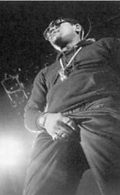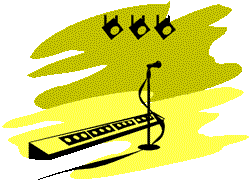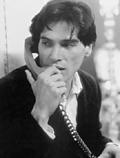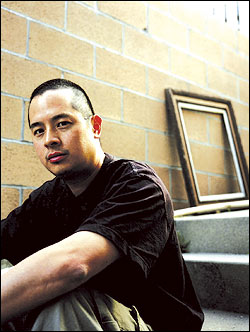SINCE THE BOAST is hip-hop’s m鴩er, it makes sense that the 20th anniversary of the music’s first appearance on wax would occasion some of the most conspicuous backslapping in recent pop-cultural memory. As a fan of the genre who’s never made the jump to full-time head, I find a lot of the hype overblown: Hip-hop may be healthier financially and more culturally dominant than ever, but too much of it right now feels bloated, artistically stagnant, and way too self-satisfied for its own good, the way rock did shortly before punk.
The Vibe History of Hip-Hop edited by Alan Light Three Rivers Press, $27.50
Ego Trip’s Book of Rap Lists by Sacha Jenkins, Elliott Wilson, Chairman Mao, Gabriel Alvarez, and Brent Rollins St. Martin’s Press/Griffin, $19.95
Even so, this sense of hubris isn’t totally unwarranted. And, after all, anniversaries have that effect on genres whose swift demise is predicted almost daily until it becomes apparent that the shit ain’t goin’ away. 1999 has seen a lot of fond looking back on hip-hop’s glorious legacy. Major names like Naughty by Nature, Gang Starr, A Tribe Called Quest, the Beastie Boys, and Wu-Tang Clan producer the RZA have all released greatest-hits packages, and two new books have been released that are directly modeled on two early rock-critical efforts. The Alan Light-edited The Vibe History of Hip Hop takes its cue from The Rolling Stone Illustrated History of Rock, originally edited by Jim Miller in 1976; and Ego Trip’s Book of Rap Lists follows the example of Dave Marsh and Kevin Stein’s 1980 Book of Rock Lists.
The Rolling Stone Illustrated History of Rock is a wide-ranging essay collection that, in both its original form and its first updated version, remains one of the great rock histories—something that can’t be said of its 1992 republication, a pointlessly lazy, barely updated mess overseen by Anthony DeCurtis. The Vibe History copies the Stone book’s structure and shares its weakness as well, offering the same glossed-over synopses that marred DeCurtis’ history, in which hip-hop—the most potent youth music since rock—was covered by a mere chapter.
The Vibe book attempts to redress that balance, and in form it succeeds: It just might be the most complete written chronicle of the genre to date. Yet, though casual fans will come away with a broadened perspective, the book’s content is extremely frustrating for anyone with more than a passing interest in hip-hop. Too many facts in the scene overviews rush past, pasted together with fluffy record-company-bio rewrites like “The conscientious, sweetly handsome crooner Keith Sweat was a new jack star that any mother could love.” (The major exception is Florida native Tony Green’s droll, beautifully written guide to southern hip-hop.) The single-artist profiles are better, though beyond Sasha Frere-Jones’s hilarious personal essay on Run-D.M.C., few pack much critical punch.
The biggest problem with the book, though, is its “the story has officially been told and we can all go home now” feel. Whatever my reservations about the current state of hip-hop, it’s still vital enough for even a casual admirer to argue over or get excited about. But The Vibe History tries so hard to be The Definitive Document that it feels mummified. And, as critic Keith Harris once put it, “I think hip-hop is art, honest. I just don’t think it belongs in a museum.”
It is, of course, entirely possible to put together a cohesive history that still has some snap to it: Three long-out-of-print gems—David Toop’s Rap Attack, rich in lore about the early hip-hop scene; Steven Hager’s breakdancing- and graffiti-heavy Hip Hop (both 1984); and Havelock Nelson and Michael A. Gonzales’ collection of sharply written artist profiles, Bring the Noise (1991)—do just that. And though it’s hardly a narrative, it’s in those volumes’ company that Ego Trip’s Book of Rap Lists belongs. (It should be noted that the two books in this review share some of the same writers: E.T. co-authors Sacha Jenkins, Chairman Mao, and Gabriel Alvarez contribute three of The Vibe History‘s best chapters.)
Where Vibe wraps nearly everything in a stifling air of worship, Ego Trip is marked by its irreverence; as one admirer said about the now-defunct magazine, it proved how much it loved hip-hop by making fun of it. This sensibility is all over the Book of Rap Lists. The lists themselves are frequently hilarious: Rhettmatic and Babu of DJ crew the Beat Junkies provide “Five Reasons Asian DJs Cut So Fresh” (“Due to many years of using chopsticks, our dexterity is perfect for DJing”); the authors list 99 songs apiece with “nigga/nigger” and “bitch” in the title (I about fell over when I realized that they had left stuff out); and, on the opposite end of the spectrum, the book includes “10 Reasons Why Will Smith Loves Miami.” (“It’s a place where he can really let go,” they deadpan.) We’re also treated to context, such as “During Arsenio Hall’s late-night television reign, he brought more thugs to America’s living rooms than Cops.”
Comedy aside, what makes Ego Trip’s Book essential is its obvious love of the music. It’s not just the authors’ passion, but also that of the plethora of old-school pioneers and new-school heads whose words are scattered throughout the text: Goodie Mob’s Cee-Lo lists his five greatest moments as a rock fan; DJ Red Alert waxes rhapsodic about the DJs who influenced him; MC Serch reminisces about his favorite old-school venues. And they’re not afraid to go out on a limb with their opinions: The book’s index offers highly contentious lists of hip-hop’s top 25 albums and 40 singles for every year since 1979—a move that should start as many arguments as that highly contentious list of the top 100 books of the century. Ego Trip’s Book doesn’t even pretend to be definitive, but something tells me it comes lot closer than Vibe‘s attempt. And that’s something worth boasting about.








